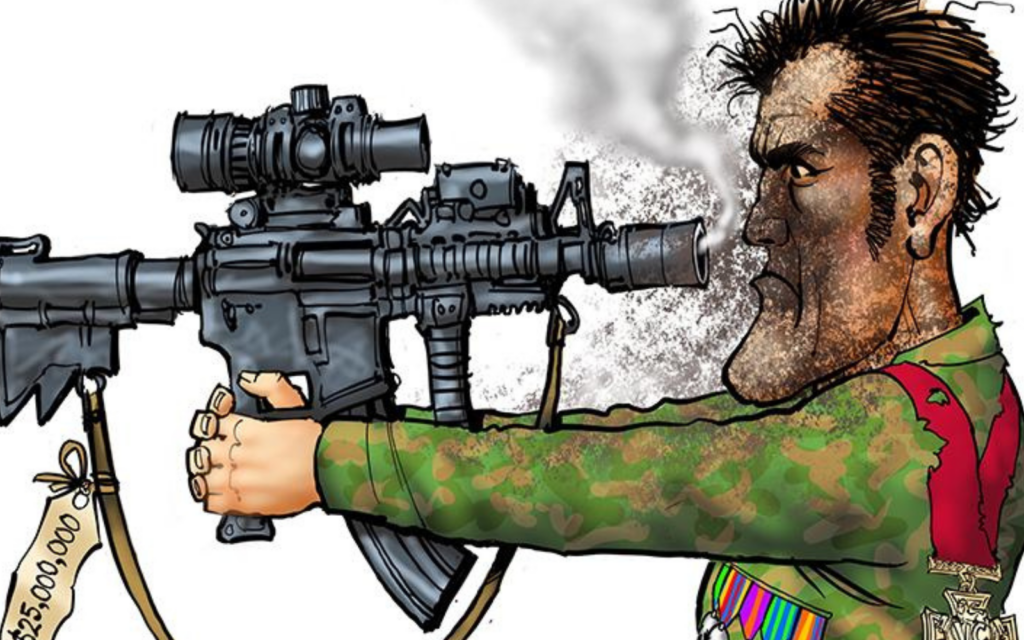Although Manifesto is a work of moving image, Rosefeldt says the focus is on text. Beat wanted to know how Manifesto came about. “In this case it’s a bit of everything,” Rosefeldt tells us when we caught up with him at ACMI after being fairly blown away by the exhibition. “When I was researching Deep Gold (an earlier black and white work), I came across some feminist artists’ manifestos that led me to artists’ manifestos in general. I wanted to engage with them in fresh surprising ways, to read them less as art history – art historians tend to treat them as ‘monuments’, not as living material – but as expressions of the younger generation, as a manifesto of youth. The manifestos are not only expressing the will to change, not just of changing their own art world, but of the artists’ own will to change themselves. At the beginning of your 20s, you become a punk, not because you don’t like your parents but because you want to change who you are. You define yourself. As an outcry, a manifesto is very loud; a loud gesture, an expression of the fiery part of an artist. You can read a manifesto like a Sarah Kane text. They are products of a very young voice. I started to read the texts like that. I thought I knew most of the artists’ work but this was interesting. I was surprised. The manifestos read like completely different texts. I had the idea of having them performed, acted out by somebody.”
That somebody is possibly the actor best placed to bring these ideas to life: Rosefeldt had seen director Todd Haynes’ 2007 homage to Bob Dylan, I’m Not There, and like everyone else, was impressed by how Cate Blanchett ‘got’ Bob Dylan. “It’s a beautiful film,” Rosefeldt notes. “It had an impact. Cate and I met through a mutual friend years before,” he continues. “We thought we might do something together. A fantastic offer! So what to do with it? You do not want to waste this opportunity! First off I always had the notion that Cate would be many people. I have always admired her acting – how she can transform herself. How she can so convincingly, so passionately, transform herself. Her acting is an art form. She has an instinct, an incredible talent, yes, but she has an instinct and sensitivity, an ability to embrace a character. It’s a phenomenal gift, an incredible gift. You can’t do that without generosity, without curiosity. She’s so smart and curious. She’ll never stop something; she’ll never say ‘Now I’ve had it.’ She will always want to explore more in her work. We talked about a cosmos of moving images; we wanted to try out something like that. I started thinking about what I could do. So there are two things, meeting her and this offer in mind. I found a way of bringing it into the artists’ manifestos.”
How do Rosefeldt’s ideas start to take shape? “It often starts with images that pop up. I write them down, collect them – far before any idea comes to mind,” he answers. “A mix of profound research which is infecting things: I’ll be working on one project, working on something and a thought will come and that project will lead to another. There are all kinds of strange weird influences. My interests are wide. I come from a background in architecture; I’m interested in film and theatre. I ended up doing art. Manifesto is inviting all these interests in a way. If you look at my work, you can see clearly ideas from architecture, the effect of architecture, the thinking involved
Rosefeldt’s work, especially in the two interior set pieces, Stunned Man (Trilogy of Failure II) (2004) and The Soundmaker (Trilogy of Failure I) (2004), both in the ACMI exhibition, are characterised by very slow panning camera shots. “The camera is like a pendulum moving across the scene with a hypnotic effect,” he explains. “The image is intended to hypnotize the viewer. A pseudo-scientific experiment is built into it as you keep watching you become part of it. These are slow-moving images, they’re calm, there’s not a lot of editing. My work is an answer to the modern frequency of editing, there’s so much action in contemporary films. If you compare films from 50 years ago to modern day films, there were 1/10th of the cuts. These films depict the other half of us, ego and alter-ego. There is tension in the field; there are two different characters inside us – inside each character. There’s a destructive side and the constructive or healthy side, and these are complicated by the things that we do. Deep Gold is part of a film anthology, The Anthology of Failure. It pays homage to Louis Buñuel’s Golden Age (L’Age D’Or). There’s a strong revolutionary feminist message in the film, where the female protagonist starts to kiss an old man. The message is that you should kiss whomever you want to kiss. Free your lust!”
BY LIZA DEZFOULI







